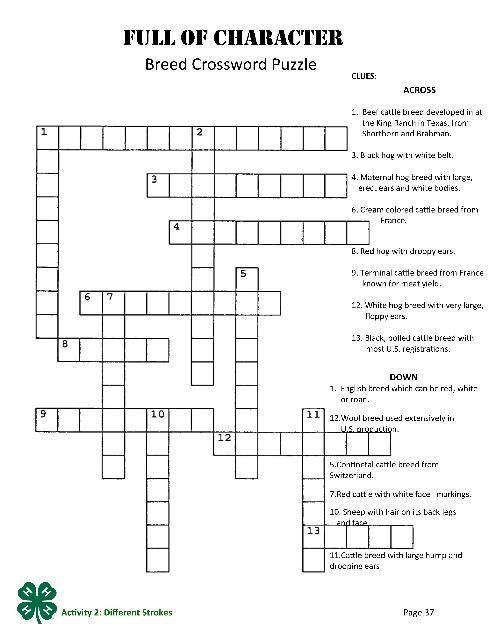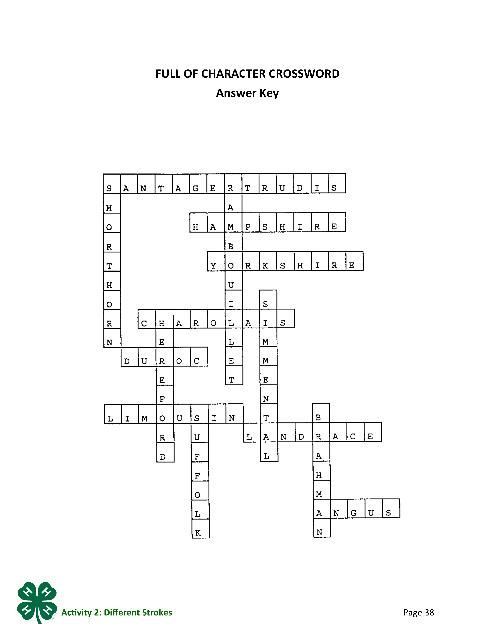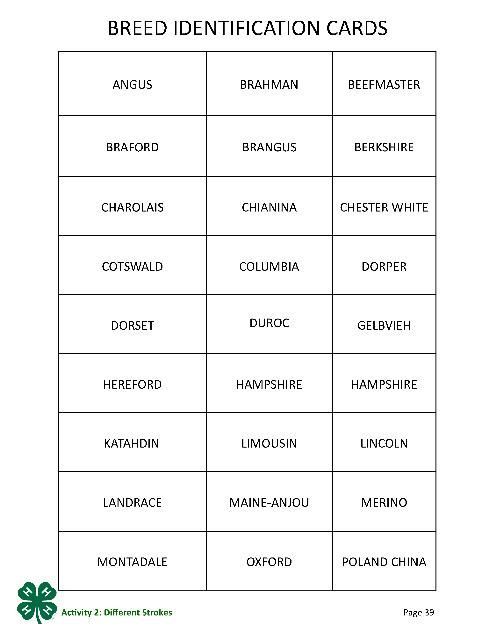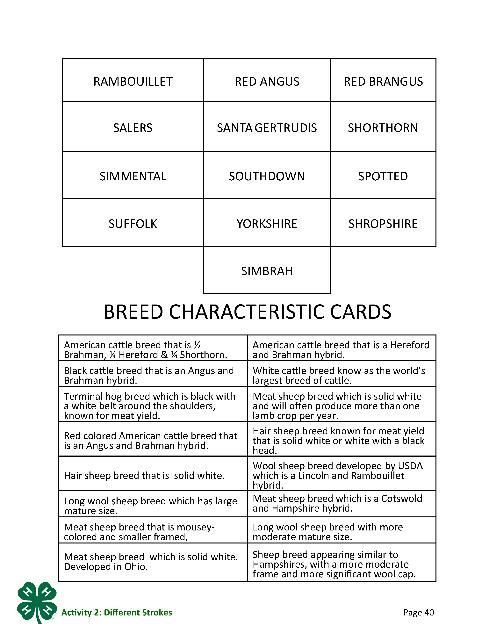
Different Strokes
Background Basics...
A breed is defined as a group of animals with a common origin which are distinguished by characteristics within a species. Breed character is defined as the characteristics that allow the breed of the individual animal to be easily determined. Different purebred breeds have different genetic strengths and weaknesses.
The offspring or progeny of different purebred breeds result in an animal that has genetic advantages compared to its parents. This is called hybrid vigor or heterosis.
Hog Breeds
The eight purebred breeds of hogs most utilized in the United States are the Landrace, Yorkshire, Duroc, Hampshire, Berkshire, Chester White, Poland China and Spotted breeds.
Generally, the three white breeds—Yorkshire, Landrace, and Chester White— excel at mothering or maternal traits, compared with the remaining breeds which have primarily been selected for growth, carcass merit, or terminal traits.
More information on the eight major purebred hog breeds can be found at http://www.ansi.okstate.edu/breeds/swine/
Cattle Breeds
Numerous cattle breeds give influence to the U.S. beef industry. Cattle breeds actually represent animals from two different species, Bos taurus and Bos Indicus.
The Bos Taurus breeds can be categorized into three groups: Dairy, British, and Continental. The Bos Indicus breeds used within the U.S. are categorized as American breeds. More information on these and other breeds can be found at http://www.ansi.okstate.edu/breeds/cattle/.
The Dairy breeds—Ayrshire, Brown Swiss, Guernsey, Holstein, Jersey, and Milking Shorthorn—are primarily utilized for milk production, but castrated bull calves certainly contribute to the beef industry.
The British breeds—Angus, Red Angus, Hereford, and Shorthorn—excel at reproductive efficiency, and marbling deposition or the amount of taste fat within the muscle tissue.
The Continental breeds—Charolais, Chianina, Gelbvieh, Limousin, Maine-Anjou, Salers, and Simmental—generally possess a large mature size, rapid growth rate, and heavy muscling. Each breed displayed distinct color patterns when imported into the U.S., however, the Charolais is now the only Continental breed which does not have black –hided animals.
American breeds—American Brahman, Braford, Brangus, Beefmaster, Red Brangus, and Santa Gertrudis—are all Bos indicus breeds of beef cattle developed in the United States. These cattle are known for heat tolerance and resistance to parasite populations. Most of these breeds are a result of crossing two or more breeds.
Sheep Breeds
There are more breeds of sheep than any other meat-animal species. More information on sheep breeds can be found at http://www.ansi.okstate.edu/breeds/sheep/. Sheep breeds can primarily be categorized into three groups: hair, wool, and meat breeds.
The two primary hair breeds—Dorper and Katahdin—are both easy care breeds which do not require shearing, primarily having hair rather than wool. The Merino, Rambouillet, and Columbia breeds are wool breeds specifically described as finewools which generate a high quality fleece which has a greater processing value for garments. The Lincoln and Cotswald breeds are also wool breeds known as longwool breeds which have a longer fleece. The primary meat breeds used in the U.S. are the Dorset, Hampshire, Montadale, Oxford, Southdown, and Suffolk. These breeds are much faster growing and have greater carcass merit than the wool breeds. The fleece quality is much poorer compared with the wool breeds. These breeds are often referred to as medium-wool breeds.
The table below shows the correct gender terminology within each of the species. These terms will often be combined to give even more information about a specific animal (e.g. heifer calf, wether lamb).
Table 1.
Introduction
Like humans, all animals have a genetic make-up. In livestock, it is easy to categorize groups based on their breed and sex characteristics. It is important for you to be able to distinguish among the types, breeds, and sexes. Ideal types and desirable characteristics vary widely among the sexes, breeds and use of the animal. Industry demands have the greatest impact on the desirable types within a breed or sex category and these will be discussed further in Activity 3. Today we will explore the different breed and sex characteristics within each species and learn to identify some of the more prominent traits of each. You will also get to know each other and learn to work together as a team through the "What Am I?" game.
DO Play What Am I?
- Divide youth into two groups
- Give each youth in the first group one BREED IDENTIFICATION Card. The youth in the second group each get one BREED CHARACTERISTICS clue card.
- Have the youth circulate around the room finding the match to their breed characteristics clue or their breed card. This can be done by asking yes/no questions, by process of elimination and by the members helping each other find the person with their matching card.
- Have youth sit down when they find their matches.
- After everyone is seated, have each pair stand up and tell the group about the characteristics of their breed. If the information is incorrect, have youth continue their search.
- Be sure that all the breeds and characteristics are covered.
Reflect
- Did you have difficulty finding your breed's characteristics or breed identification?
- Which sheep breed has the greatest fleece quality?
Merino
- List some similarities among the swine breeds.
Example: Poland China and Berkshire each are black with six white points.
- How are American breeds of beef cattle different from the British or Continental breeds?
American breeds were all developed here in the US and are a hybrid cross of at least two breeds. These animals are more adapted to tropical environments than British or Continental breed cattle.
- What is the purpose of crossing the breeds during reproduction?
This results in heterosis or hybrid vigor.
- Does the proper development of sexual characteristics influence the animal's net worth? Why?
Yes. The improper development of necessary sexual characteristics could produce an animal who is infertile or has other reproductive malfunctions and is of very little use to the producer. Development of desirable sexual characteristics could influence whether the animal gets chosen for reproductive or slaughter purposes, therefore having an influence on the animal's net worth.
- Did you make any friends or meet someone new?
Apply
- Visit an exhibit of animals (fair, youth show...) or a local ranch or farm. Discuss the characteristics and positive/negative attributes of each breed that you encounter, as well as identify the animal's sex.
- Complete the FULL OF CHARACTER Crossword puzzle.
Breed Identification
Angus—English, black, polled cattle breed, known for meat quality and reproductive efficiently.
Charolais—Continental cream colored cattle breed, known for growth, which originated in France.
Oxford —Meat sheep breed which is a Cotswold and Hampshire hybrid.
American Brahman—Bos indicus (cattle of India) cattle breed that is grey or red, has a large hump and drooping ears. Known for heat tolerance and parasite resistance.
Berkshire—Black hog breed with six white points, erect ears, known for meat quality.
Dorper—Hair sheep breed known for meat yield that is solid white or white with a black head. Developed in South Africa.
Shorthorn—English cattle breed that can be red, white, or roan.
Landrace—Maternal white hog breed with very large, floppy ears.
Beefmaster—American, Bos Indicus cattle breed that is Brahman, Hereford and Shorthorn. Developed at the Lasater Ranch.
Montadale—Meat sheep breed which is solid white. Developed in Ohio.
Braford—American, Bos Indicus cattle breed developed in Florida which is a Hereford and Brahman hybrid.
Brangus—American, Bos Indicus cattle breed which is an Angus and Brahman hybrid.
Chianina—Continental cattle breed from Italy known for extreme frame. Original animals were solid white.
Dorset—Meat sheep breed which is solid white and will often produce more than one lamb crop per year.
Hampshire—Terminal hog breed which is black with a white belt around the shoulders, known for meat yield.
Chester White—White hog breed with medium sized, droopy ears, best meat quality.
Katahdin—Hair sheep breed that is solid white. Developed in Maine.
Spotted—Terminal hog breed with large black spots. Primary current use; show pig genetics.
Yorkshire—Maternal white hog breed of hogs with erect ears.
Shropshire—Meat sheep breed appearing similar to Hampshires, with a more moderate frame and more significant wool cap.
Gelbvieh—Continental cattle breed from Germany known for maternal performance. Original animals were red.
Hereford—English cattle breed with a red body and white face and underline.
Southdown—Meat sheep breed that is mousey-colored and smaller framed, but produces a well-muscled carcass.
Maine-Anjou—Continental cattle breed from France, currently used extensively in show cattle ge-netics. Original animals were red and white spotted.
Salers—Most recent continental cattle breed imported from France. Original animals were dark red.
Red—Red colored American, Bos Indicus cattle breed that is an Angus and Brahman hybrid.
Cotswald—Long wool sheep breed with more moderate mature size.
Simmental—Continental cattle breed from Switzerland known for milk production and growth. Original animals were red and white.
Columbia—Wool sheep breed developed by USDA which is a Lincoln and Rambouillet hybrid.
Santa Gertrudis—American, Bos Indicus cattle breed that is a Shorthorn and Brahman hybrid. Developed in at the King Ranch in Texas.
Suffolk—Meat sheep breed with largest number of U.S. registrations. Has black hair on their face and legs.
Rambouillet—Wool sheep breed which is extensively utilized in western U.S. range sheep production.
Red Angus—English, polled cattle breed, which are red in color.
Poland Chin —Terminal black hog breed with six white points and droopy ears. Primary current use show pig genetics.
Hampshire—Very popular sheep breed with wool on their black face and legs.
Merino—Wool sheep breed with highest quality fleece.
Limousin—Continental breed from France known for meat yield. Original animals were red.
Duroc—Terminal breed of red hogs with droopy ears. Known for rapid growth.
Lincoln—Long wool sheep breed which has large mature size.
Simbrah—American, Bos Indicus cattle breed that is a Simmental and Brahman hybrid.
FULL OF CHARACTER





Swine Breed Associations
American Landrace Assn., Inc.
Hampshire Swine Registry
American Yorkshire Club, Inc.
United Duroc Swine Registry
are collectively called
National Swine Registry
2639 Yeager Rd.
West Lafayette, IN 47906
https://nationalswine.com/
American Berkshire Assn.
P.O Box 2436
West Lafayette, IN 47996
http://www.americanberkshire.com
Chester White Swine Record Assn.
Poland China Record Assn.
National Spotted Swine Record, Inc.
are collectively called
Certified Pedigreed Swine
Box 9758
Peoria, IL 61612-9758
Cattle Breed Associations
American Angus Association
3201 Frederick Ave.
St. Joseph, MO 64501
http://www.angus.org
American Brahman Breeders Assn
3003 South Loop West, Suite 520
Houston, TX 77054
http://www.brahman.org
International Brangus Breeders Assn.
P.O. Box 10029
College Station, TX 77842
https://gobrangus.com/
American-International Charolais Assn.
11700 NW Plaza Circle
Kansas City, MO 64153
http://www.charolaisusa.com
American Chianina Assn.
P.O. Box 159
Blue Springs, MO 64015
http://www.chicattle.org
United Braford Breeders
P.O. Box 14100
Kansas City, MO 64101
http://www.brafords.org
Beefmaster Breeders United
6800 Park Ten Blvd.
Suite 290 West
San Antonio, TX 78213
http://www.beefmasters.org/
Red Angus Assn. of America
P.O. Box 776
Denton, TX 76201
American Gelbvieh Assn.
311 Livestock Exchange Building
Denver, CO 80216
http://www.gelbvieh.org
American Hereford Assn.
PO Box 014059
Kansas City, MO 64101
http://www.hereford.org
North American Limousin Foundation
100 Livestock Exchange Building
4701 Marion Street
Denver, CO 80216
http://www.nalf.org
American Maine-Anjou Association
204 Marshall Road
PO Box 1100
Platte City, MO 64079-1100
http://www.maine-anjou.org/
American Salers Association
19590 E. Mainstreet #202
Parker, CO 80138
http://www.salersusa.org/
American Simmental Association
Simbrah Registry
1 Simmental Way
Bozeman, MT 59715-9733
http://www.simmental.org/
American Red Brangus Association
3995 East Hwy. 290
Drippings Springs, TX 78620
http://www.americanredbrangus.org/
Santa Gertrudis Breeders International
PO Box 1257
Kingsville, TX 78364
http://santagertrudis.com/
American Shorthorn Association
8288 Hascall Street
Omaha, NE 68124
http://www.shorthorn.org/
Beefmaster Breeders United
6800 Park Ten Blvd. Suite 290 West
San Antonio, TX 78213
http://www.beefmasters.org/
Sheep Breed Associations
Continental Dorset Club
P.O. Box 506
Hudson, IA 50643
http://www.dorsets.homestead.com
Columbia Sheep Breeders Assn.
P.O. Box 272
Upper Sandusky, OH 43351
http://www.columbiasheep.org
American Corriedale Assn., Inc.
PO Box 391
Clay City, IL 62824
http://www.americancorriedale.com
American Hampshire Sheep Assn.
P.O. Box 27
Sedalia, MO 65302
https://www.hampshires.org/
American Rambouillet Breeders Assn.
2709 Sherwood Way
San Angelo, TX 76901
http://www.rambouilletsheep.org
American Delaine & Merino Assn.
1026 Co. Road 1175, Rt. 3
Ashland, OH 44805
https://admra.net/
Montadale Sheep Breeders Assn.
PO Box 603
Plainfield, IN 46168
http://www.montadales.com
American Southdown Breeder's Assn.
HCR 13, Box 220
Fredonia, TX 76842
http://www.southdownsheep.org
American Shropshire Registry Assn.
6508 West R Ave.
Schoolcraft, MI 49087
http://www.shropshires.org
Natl. Lincoln Sheep Breeders Assn.
15603 173rd Ave
Milo, IA 50166
https://www.lincolnsheepbreeders.com/
American Oxford Sheep Assn.
8650 Wheatland Road
Burlington, WI 53105
http://www.americanoxfords.org
American Cotswold Record Assn.
P.O. Box 59
Plympton, MA 02367
http://www.cotswoldsheep.us.com
United Suffolk Sheep Association
P.O. Box 121
Holland, IA 50642
https://suffolks.org/
American Dorper Sheep Breeders Society
PO Box 259
Hallsville, MO 65255-0259
http://www.dorperamerica.org/
Katahdin Hair Sheep International Registry
15603 173rd Ave
Milo, IA 50166
http://www.katahdins.org/
Tables
Activity 2.